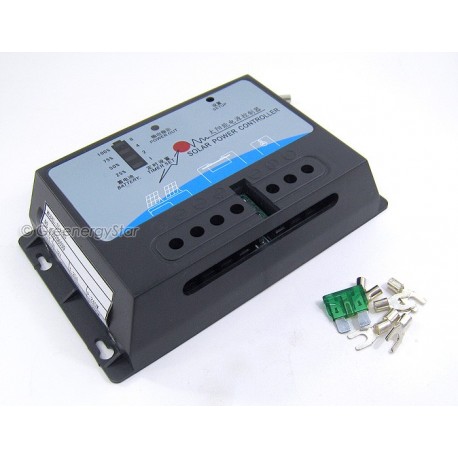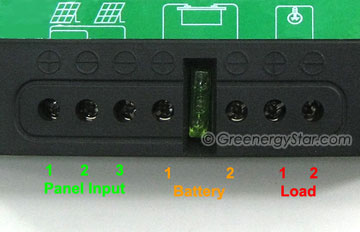No products
Product successfully added to your shopping cart
There are 0 items in your cart. There is 1 item in your cart.
 View larger
View larger
More info
 |
Introduction:
The charge controller regulates the flow of electricity from the solar modules to the battery bank. When the battery bank is low, the charge controller feeds all of the electricity from the array / generator to the batteries. When the batteries reach a state of full charge, the charge controller stops or redirects the supply of electricity to prevent overcharging. Modern charge controllers have the ability to hold the battery bank in a "float" state of charge if the bank is not being used. At night the charge controller prevents a reverse flow of current from the batteries to the modules.
There are three basic types of charge controllers - series, shunt and pulse-width-modulated. A series controller, the most basic type, acts as a switch to disconnect and re-connect the solar modules to the battery bank. A shunt type controller redirects the current from the solar modules - either by simply short circuiting the array or by directing the current to some other load. Pulse-width-modulated charge controllers, the most up-to-date type, maintain the battery bank in a float state of charge. "Float" is the voltage level just below gassing voltage. Keeping the batteries in this state of charge delivers their best possible life without using excessive electrolytic.
Many people have asked about power point tracking and whether it has any real advantages. Maximum Power Point Tracking (MPPT) converts the difference between a solar modules rated voltage, (usually 17 volts) and a battery banks charging voltage (up to 14.7 volts) into usable charging current. Often claims are made for up to a 30% increase in charging current. This gain, however, is possible under a very limited set of conditions. The "extra" module voltage is there for a reason: to allow for real world use of the solar module, i.e. the voltage drop caused by the array wiring and other components, including the charge controller, between the solar array and batteries. Also, high ambient temperatures cause the solar module to drop in voltage further reducing this "extra" voltage.
Having said that, there are times when the voltage difference will be high enough to provide extra current to a battery bank utilizing this type of charge controller. Cold weather comes to mind, as well as low battery bank voltage. Under these conditions, it can be possible to get as much as 10% to 30% more current from your solar modules.
Feature:
Pulse-width-modulated to keep battery bank at a "float" state of charge
Maximize Efficiency with Max Power Point Tracking (around 30% increase in charge)
Built in diode to prevent reverse flow of current back to the modules
Temperature Compensation
Maximum Output: 20A
Voltage: 12V
Continue Power: 240W
Over-charge Protection
Over discharge protection
Compatible with Solar System
Can use AC Power as source
Includes:
- Charge Controller
- Temperature detector
- Extra 20A Fuse
- 7 connectors
- Instruction Manual
Specification:
|
||||||||||||||||||||||||||||||||||||||||||||||||||||||||||||||||||||||||||||
Types of Connection:
|
|||||||||
NO OPERATING COST
GENERATES ELECTRICITY FROM THE ABUNDANT RESOURCE
Reviews
No customer reviews for the moment.



